Organisational Change, Leadership, and Strategy Analysis Report
VerifiedAdded on 2022/12/16
|17
|5539
|34
Report
AI Summary
This report delves into the intricacies of organizational change, exploring its impact on employee behavior and leadership dynamics. It examines how external factors like political, economic, social, and technological shifts influence organizational strategy, utilizing PEST analysis of Sainsbury to illustrate these effects. The report compares how different organizations, specifically Sainsbury and Morrison, have adapted to strategic and operational changes, particularly in response to the COVID-19 pandemic. It further analyzes how internal and external changes affect leadership within organizations, discussing strategies to mitigate the negative impacts of change and addressing common barriers to successful implementation. The report also covers various leadership approaches and relevant theories, providing a comprehensive understanding of change management within a business context.
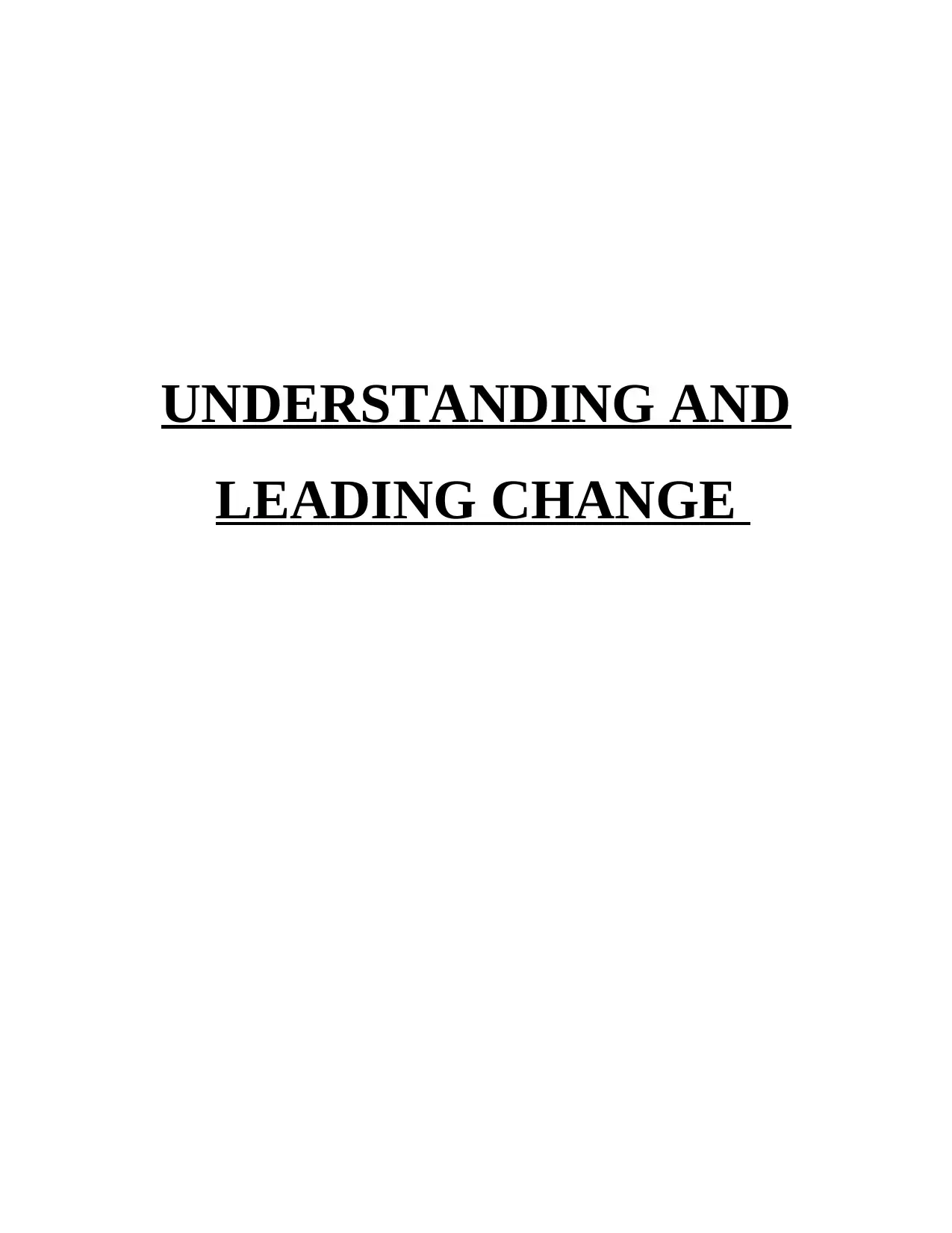
UNDERSTANDING AND
LEADING CHANGE
LEADING CHANGE
Paraphrase This Document
Need a fresh take? Get an instant paraphrase of this document with our AI Paraphraser
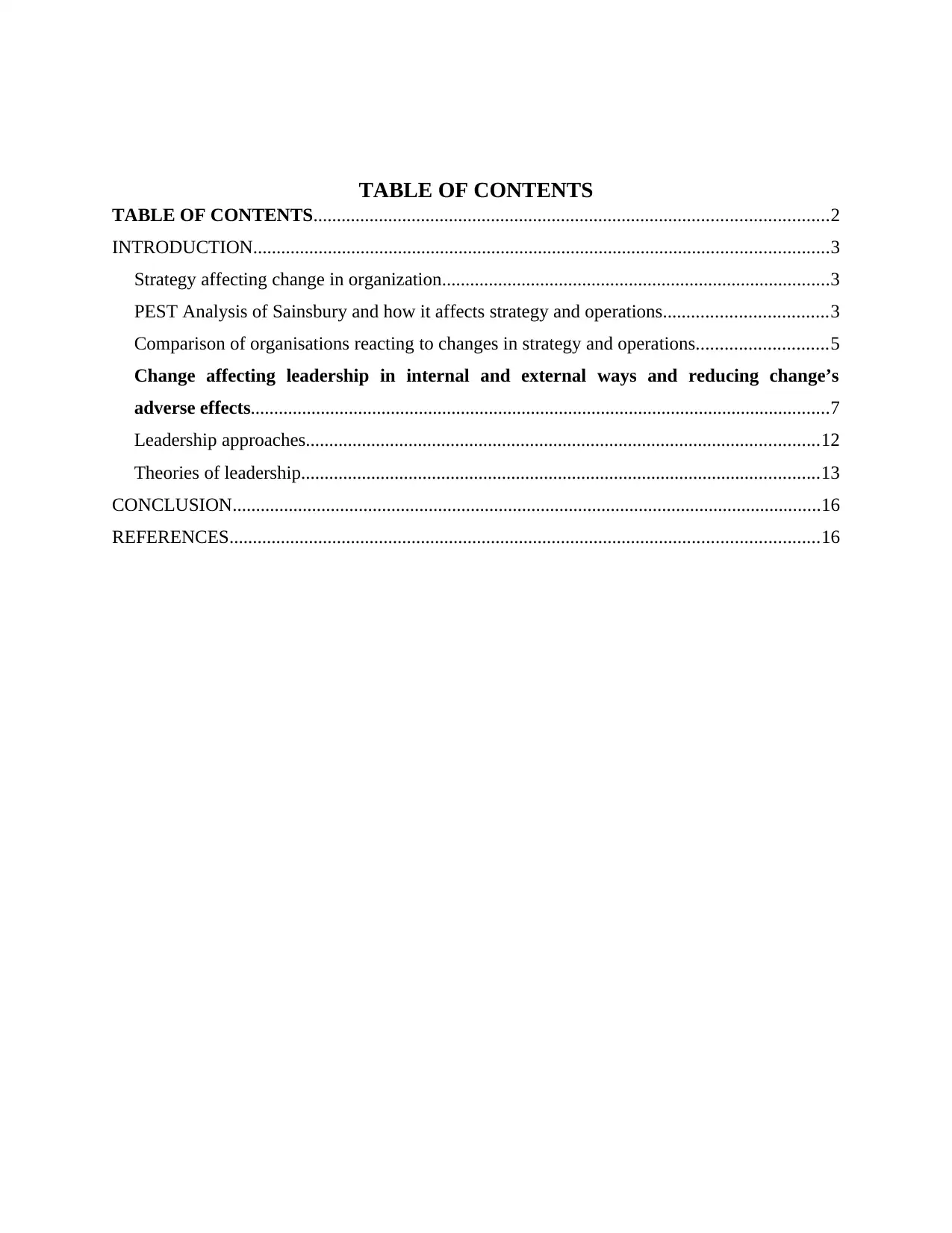
TABLE OF CONTENTS
TABLE OF CONTENTS..............................................................................................................2
INTRODUCTION...........................................................................................................................3
Strategy affecting change in organization...................................................................................3
PEST Analysis of Sainsbury and how it affects strategy and operations...................................3
Comparison of organisations reacting to changes in strategy and operations............................5
Change affecting leadership in internal and external ways and reducing change’s
adverse effects............................................................................................................................7
Leadership approaches..............................................................................................................12
Theories of leadership...............................................................................................................13
CONCLUSION..............................................................................................................................16
REFERENCES..............................................................................................................................16
TABLE OF CONTENTS..............................................................................................................2
INTRODUCTION...........................................................................................................................3
Strategy affecting change in organization...................................................................................3
PEST Analysis of Sainsbury and how it affects strategy and operations...................................3
Comparison of organisations reacting to changes in strategy and operations............................5
Change affecting leadership in internal and external ways and reducing change’s
adverse effects............................................................................................................................7
Leadership approaches..............................................................................................................12
Theories of leadership...............................................................................................................13
CONCLUSION..............................................................................................................................16
REFERENCES..............................................................................................................................16
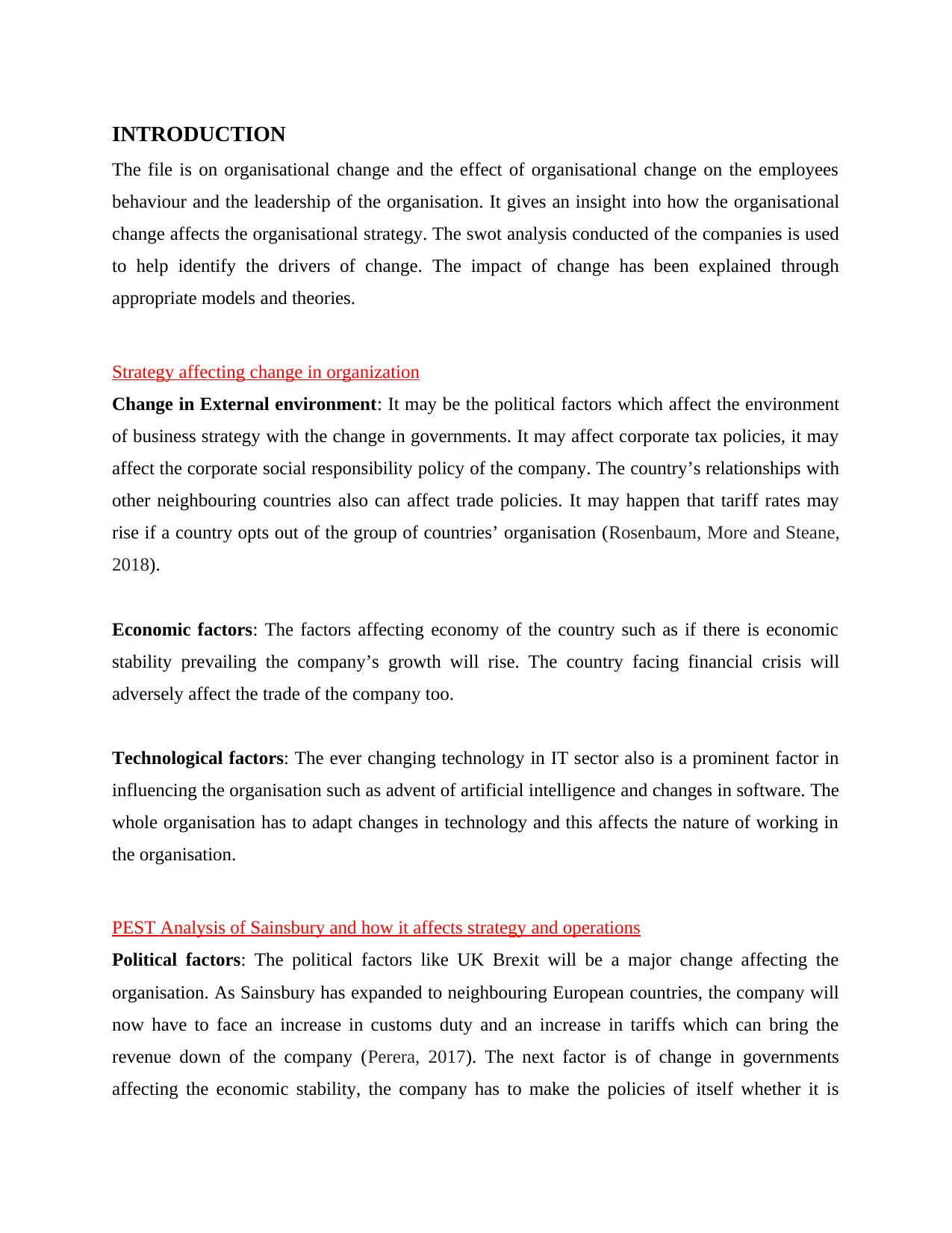
INTRODUCTION
The file is on organisational change and the effect of organisational change on the employees
behaviour and the leadership of the organisation. It gives an insight into how the organisational
change affects the organisational strategy. The swot analysis conducted of the companies is used
to help identify the drivers of change. The impact of change has been explained through
appropriate models and theories.
Strategy affecting change in organization
Change in External environment: It may be the political factors which affect the environment
of business strategy with the change in governments. It may affect corporate tax policies, it may
affect the corporate social responsibility policy of the company. The country’s relationships with
other neighbouring countries also can affect trade policies. It may happen that tariff rates may
rise if a country opts out of the group of countries’ organisation (Rosenbaum, More and Steane,
2018).
Economic factors: The factors affecting economy of the country such as if there is economic
stability prevailing the company’s growth will rise. The country facing financial crisis will
adversely affect the trade of the company too.
Technological factors: The ever changing technology in IT sector also is a prominent factor in
influencing the organisation such as advent of artificial intelligence and changes in software. The
whole organisation has to adapt changes in technology and this affects the nature of working in
the organisation.
PEST Analysis of Sainsbury and how it affects strategy and operations
Political factors: The political factors like UK Brexit will be a major change affecting the
organisation. As Sainsbury has expanded to neighbouring European countries, the company will
now have to face an increase in customs duty and an increase in tariffs which can bring the
revenue down of the company (Perera, 2017). The next factor is of change in governments
affecting the economic stability, the company has to make the policies of itself whether it is
The file is on organisational change and the effect of organisational change on the employees
behaviour and the leadership of the organisation. It gives an insight into how the organisational
change affects the organisational strategy. The swot analysis conducted of the companies is used
to help identify the drivers of change. The impact of change has been explained through
appropriate models and theories.
Strategy affecting change in organization
Change in External environment: It may be the political factors which affect the environment
of business strategy with the change in governments. It may affect corporate tax policies, it may
affect the corporate social responsibility policy of the company. The country’s relationships with
other neighbouring countries also can affect trade policies. It may happen that tariff rates may
rise if a country opts out of the group of countries’ organisation (Rosenbaum, More and Steane,
2018).
Economic factors: The factors affecting economy of the country such as if there is economic
stability prevailing the company’s growth will rise. The country facing financial crisis will
adversely affect the trade of the company too.
Technological factors: The ever changing technology in IT sector also is a prominent factor in
influencing the organisation such as advent of artificial intelligence and changes in software. The
whole organisation has to adapt changes in technology and this affects the nature of working in
the organisation.
PEST Analysis of Sainsbury and how it affects strategy and operations
Political factors: The political factors like UK Brexit will be a major change affecting the
organisation. As Sainsbury has expanded to neighbouring European countries, the company will
now have to face an increase in customs duty and an increase in tariffs which can bring the
revenue down of the company (Perera, 2017). The next factor is of change in governments
affecting the economic stability, the company has to make the policies of itself whether it is
⊘ This is a preview!⊘
Do you want full access?
Subscribe today to unlock all pages.

Trusted by 1+ million students worldwide
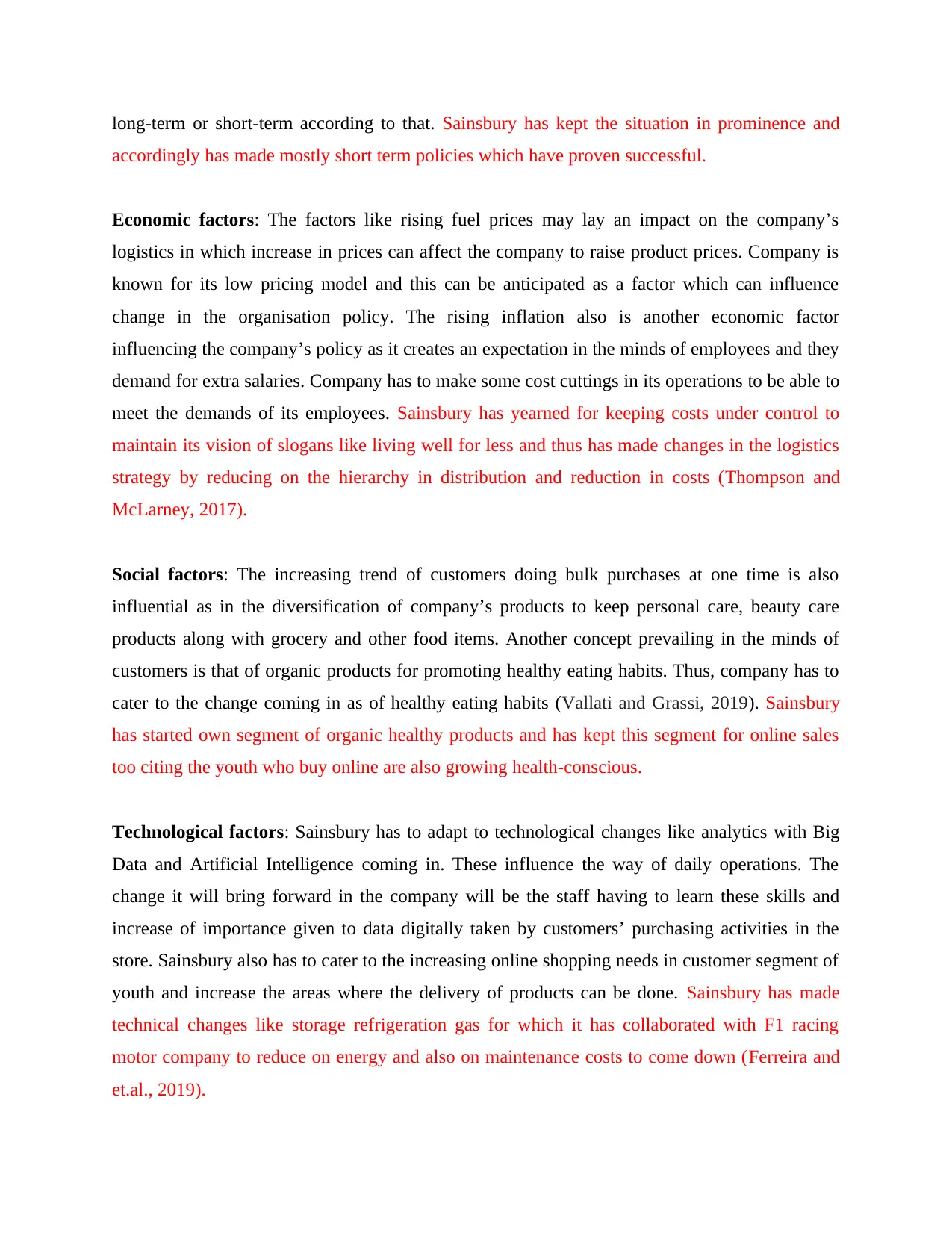
long-term or short-term according to that. Sainsbury has kept the situation in prominence and
accordingly has made mostly short term policies which have proven successful.
Economic factors: The factors like rising fuel prices may lay an impact on the company’s
logistics in which increase in prices can affect the company to raise product prices. Company is
known for its low pricing model and this can be anticipated as a factor which can influence
change in the organisation policy. The rising inflation also is another economic factor
influencing the company’s policy as it creates an expectation in the minds of employees and they
demand for extra salaries. Company has to make some cost cuttings in its operations to be able to
meet the demands of its employees. Sainsbury has yearned for keeping costs under control to
maintain its vision of slogans like living well for less and thus has made changes in the logistics
strategy by reducing on the hierarchy in distribution and reduction in costs (Thompson and
McLarney, 2017).
Social factors: The increasing trend of customers doing bulk purchases at one time is also
influential as in the diversification of company’s products to keep personal care, beauty care
products along with grocery and other food items. Another concept prevailing in the minds of
customers is that of organic products for promoting healthy eating habits. Thus, company has to
cater to the change coming in as of healthy eating habits (Vallati and Grassi, 2019). Sainsbury
has started own segment of organic healthy products and has kept this segment for online sales
too citing the youth who buy online are also growing health-conscious.
Technological factors: Sainsbury has to adapt to technological changes like analytics with Big
Data and Artificial Intelligence coming in. These influence the way of daily operations. The
change it will bring forward in the company will be the staff having to learn these skills and
increase of importance given to data digitally taken by customers’ purchasing activities in the
store. Sainsbury also has to cater to the increasing online shopping needs in customer segment of
youth and increase the areas where the delivery of products can be done. Sainsbury has made
technical changes like storage refrigeration gas for which it has collaborated with F1 racing
motor company to reduce on energy and also on maintenance costs to come down (Ferreira and
et.al., 2019).
accordingly has made mostly short term policies which have proven successful.
Economic factors: The factors like rising fuel prices may lay an impact on the company’s
logistics in which increase in prices can affect the company to raise product prices. Company is
known for its low pricing model and this can be anticipated as a factor which can influence
change in the organisation policy. The rising inflation also is another economic factor
influencing the company’s policy as it creates an expectation in the minds of employees and they
demand for extra salaries. Company has to make some cost cuttings in its operations to be able to
meet the demands of its employees. Sainsbury has yearned for keeping costs under control to
maintain its vision of slogans like living well for less and thus has made changes in the logistics
strategy by reducing on the hierarchy in distribution and reduction in costs (Thompson and
McLarney, 2017).
Social factors: The increasing trend of customers doing bulk purchases at one time is also
influential as in the diversification of company’s products to keep personal care, beauty care
products along with grocery and other food items. Another concept prevailing in the minds of
customers is that of organic products for promoting healthy eating habits. Thus, company has to
cater to the change coming in as of healthy eating habits (Vallati and Grassi, 2019). Sainsbury
has started own segment of organic healthy products and has kept this segment for online sales
too citing the youth who buy online are also growing health-conscious.
Technological factors: Sainsbury has to adapt to technological changes like analytics with Big
Data and Artificial Intelligence coming in. These influence the way of daily operations. The
change it will bring forward in the company will be the staff having to learn these skills and
increase of importance given to data digitally taken by customers’ purchasing activities in the
store. Sainsbury also has to cater to the increasing online shopping needs in customer segment of
youth and increase the areas where the delivery of products can be done. Sainsbury has made
technical changes like storage refrigeration gas for which it has collaborated with F1 racing
motor company to reduce on energy and also on maintenance costs to come down (Ferreira and
et.al., 2019).
Paraphrase This Document
Need a fresh take? Get an instant paraphrase of this document with our AI Paraphraser
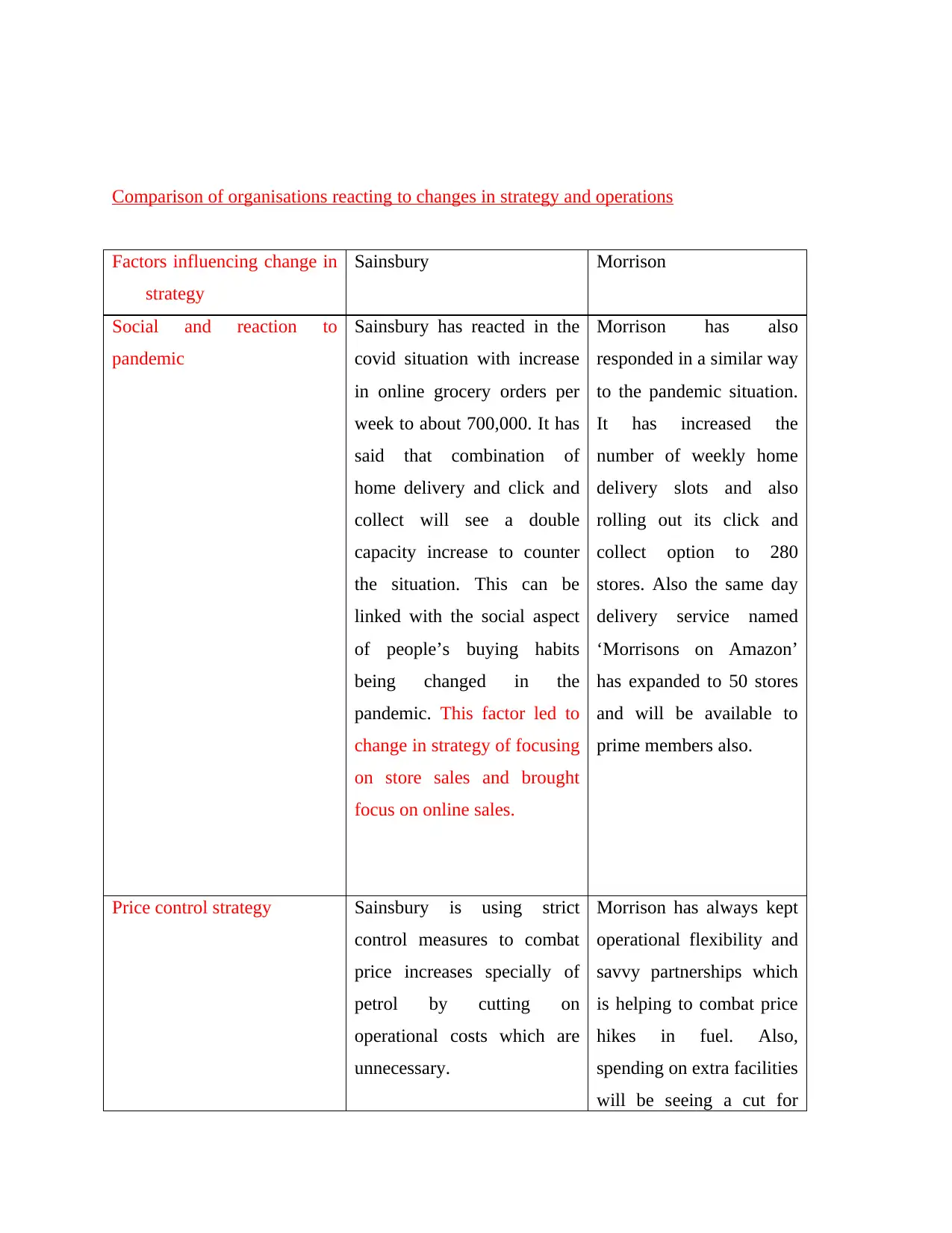
Comparison of organisations reacting to changes in strategy and operations
Factors influencing change in
strategy
Sainsbury Morrison
Social and reaction to
pandemic
Sainsbury has reacted in the
covid situation with increase
in online grocery orders per
week to about 700,000. It has
said that combination of
home delivery and click and
collect will see a double
capacity increase to counter
the situation. This can be
linked with the social aspect
of people’s buying habits
being changed in the
pandemic. This factor led to
change in strategy of focusing
on store sales and brought
focus on online sales.
Morrison has also
responded in a similar way
to the pandemic situation.
It has increased the
number of weekly home
delivery slots and also
rolling out its click and
collect option to 280
stores. Also the same day
delivery service named
‘Morrisons on Amazon’
has expanded to 50 stores
and will be available to
prime members also.
Price control strategy Sainsbury is using strict
control measures to combat
price increases specially of
petrol by cutting on
operational costs which are
unnecessary.
Morrison has always kept
operational flexibility and
savvy partnerships which
is helping to combat price
hikes in fuel. Also,
spending on extra facilities
will be seeing a cut for
Factors influencing change in
strategy
Sainsbury Morrison
Social and reaction to
pandemic
Sainsbury has reacted in the
covid situation with increase
in online grocery orders per
week to about 700,000. It has
said that combination of
home delivery and click and
collect will see a double
capacity increase to counter
the situation. This can be
linked with the social aspect
of people’s buying habits
being changed in the
pandemic. This factor led to
change in strategy of focusing
on store sales and brought
focus on online sales.
Morrison has also
responded in a similar way
to the pandemic situation.
It has increased the
number of weekly home
delivery slots and also
rolling out its click and
collect option to 280
stores. Also the same day
delivery service named
‘Morrisons on Amazon’
has expanded to 50 stores
and will be available to
prime members also.
Price control strategy Sainsbury is using strict
control measures to combat
price increases specially of
petrol by cutting on
operational costs which are
unnecessary.
Morrison has always kept
operational flexibility and
savvy partnerships which
is helping to combat price
hikes in fuel. Also,
spending on extra facilities
will be seeing a cut for
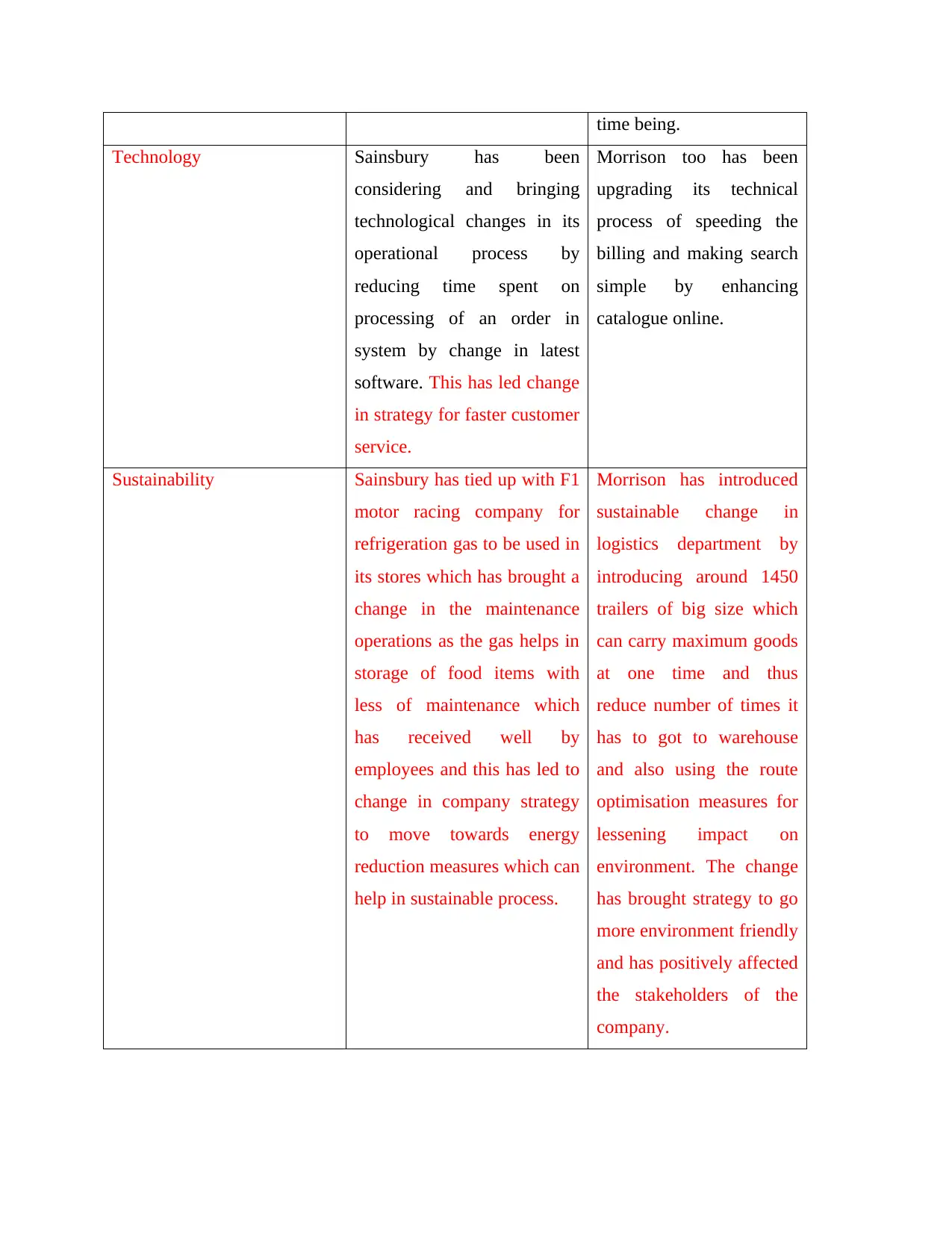
time being.
Technology Sainsbury has been
considering and bringing
technological changes in its
operational process by
reducing time spent on
processing of an order in
system by change in latest
software. This has led change
in strategy for faster customer
service.
Morrison too has been
upgrading its technical
process of speeding the
billing and making search
simple by enhancing
catalogue online.
Sustainability Sainsbury has tied up with F1
motor racing company for
refrigeration gas to be used in
its stores which has brought a
change in the maintenance
operations as the gas helps in
storage of food items with
less of maintenance which
has received well by
employees and this has led to
change in company strategy
to move towards energy
reduction measures which can
help in sustainable process.
Morrison has introduced
sustainable change in
logistics department by
introducing around 1450
trailers of big size which
can carry maximum goods
at one time and thus
reduce number of times it
has to got to warehouse
and also using the route
optimisation measures for
lessening impact on
environment. The change
has brought strategy to go
more environment friendly
and has positively affected
the stakeholders of the
company.
Technology Sainsbury has been
considering and bringing
technological changes in its
operational process by
reducing time spent on
processing of an order in
system by change in latest
software. This has led change
in strategy for faster customer
service.
Morrison too has been
upgrading its technical
process of speeding the
billing and making search
simple by enhancing
catalogue online.
Sustainability Sainsbury has tied up with F1
motor racing company for
refrigeration gas to be used in
its stores which has brought a
change in the maintenance
operations as the gas helps in
storage of food items with
less of maintenance which
has received well by
employees and this has led to
change in company strategy
to move towards energy
reduction measures which can
help in sustainable process.
Morrison has introduced
sustainable change in
logistics department by
introducing around 1450
trailers of big size which
can carry maximum goods
at one time and thus
reduce number of times it
has to got to warehouse
and also using the route
optimisation measures for
lessening impact on
environment. The change
has brought strategy to go
more environment friendly
and has positively affected
the stakeholders of the
company.
⊘ This is a preview!⊘
Do you want full access?
Subscribe today to unlock all pages.

Trusted by 1+ million students worldwide
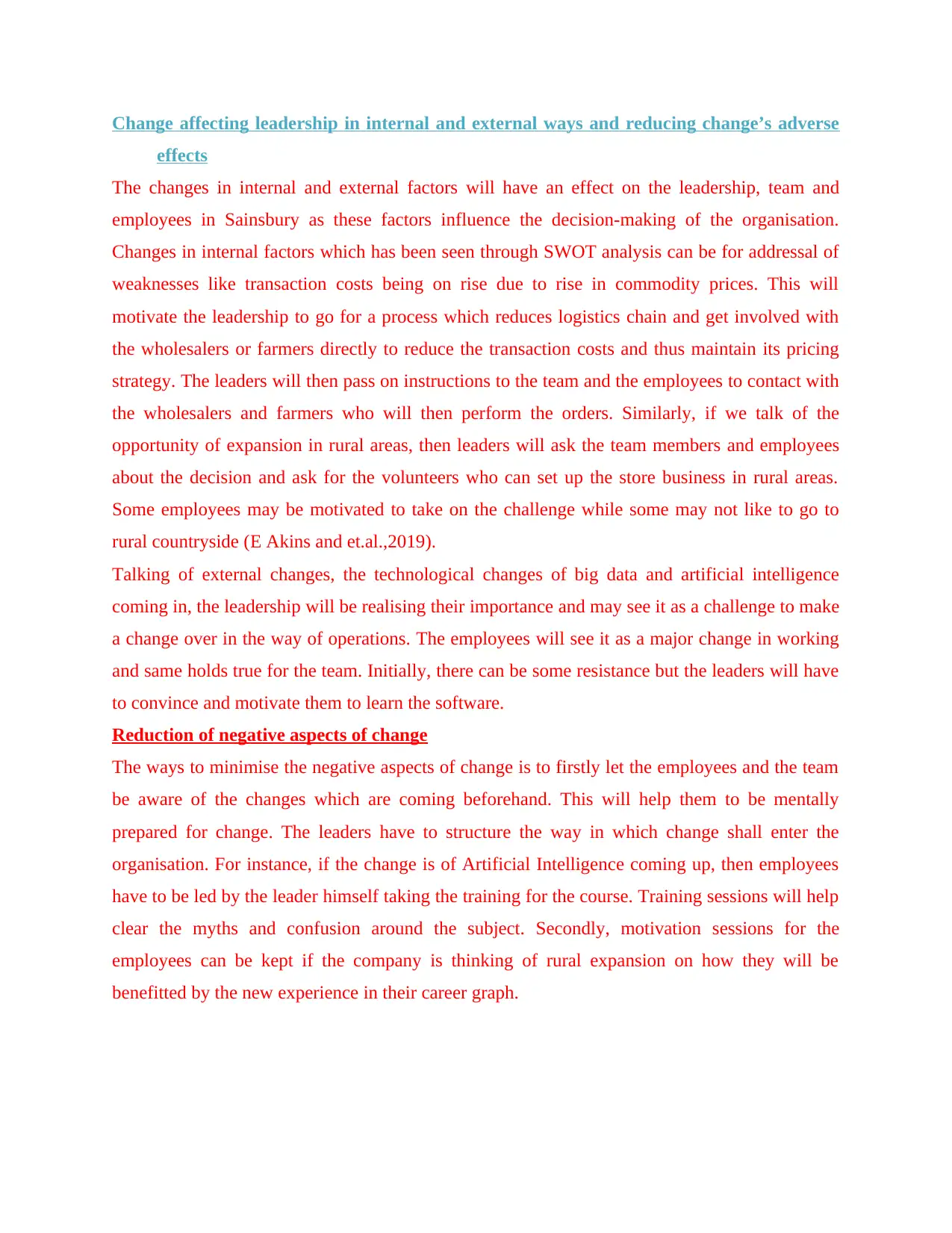
Change affecting leadership in internal and external ways and reducing change’s adverse
effects
The changes in internal and external factors will have an effect on the leadership, team and
employees in Sainsbury as these factors influence the decision-making of the organisation.
Changes in internal factors which has been seen through SWOT analysis can be for addressal of
weaknesses like transaction costs being on rise due to rise in commodity prices. This will
motivate the leadership to go for a process which reduces logistics chain and get involved with
the wholesalers or farmers directly to reduce the transaction costs and thus maintain its pricing
strategy. The leaders will then pass on instructions to the team and the employees to contact with
the wholesalers and farmers who will then perform the orders. Similarly, if we talk of the
opportunity of expansion in rural areas, then leaders will ask the team members and employees
about the decision and ask for the volunteers who can set up the store business in rural areas.
Some employees may be motivated to take on the challenge while some may not like to go to
rural countryside (E Akins and et.al.,2019).
Talking of external changes, the technological changes of big data and artificial intelligence
coming in, the leadership will be realising their importance and may see it as a challenge to make
a change over in the way of operations. The employees will see it as a major change in working
and same holds true for the team. Initially, there can be some resistance but the leaders will have
to convince and motivate them to learn the software.
Reduction of negative aspects of change
The ways to minimise the negative aspects of change is to firstly let the employees and the team
be aware of the changes which are coming beforehand. This will help them to be mentally
prepared for change. The leaders have to structure the way in which change shall enter the
organisation. For instance, if the change is of Artificial Intelligence coming up, then employees
have to be led by the leader himself taking the training for the course. Training sessions will help
clear the myths and confusion around the subject. Secondly, motivation sessions for the
employees can be kept if the company is thinking of rural expansion on how they will be
benefitted by the new experience in their career graph.
effects
The changes in internal and external factors will have an effect on the leadership, team and
employees in Sainsbury as these factors influence the decision-making of the organisation.
Changes in internal factors which has been seen through SWOT analysis can be for addressal of
weaknesses like transaction costs being on rise due to rise in commodity prices. This will
motivate the leadership to go for a process which reduces logistics chain and get involved with
the wholesalers or farmers directly to reduce the transaction costs and thus maintain its pricing
strategy. The leaders will then pass on instructions to the team and the employees to contact with
the wholesalers and farmers who will then perform the orders. Similarly, if we talk of the
opportunity of expansion in rural areas, then leaders will ask the team members and employees
about the decision and ask for the volunteers who can set up the store business in rural areas.
Some employees may be motivated to take on the challenge while some may not like to go to
rural countryside (E Akins and et.al.,2019).
Talking of external changes, the technological changes of big data and artificial intelligence
coming in, the leadership will be realising their importance and may see it as a challenge to make
a change over in the way of operations. The employees will see it as a major change in working
and same holds true for the team. Initially, there can be some resistance but the leaders will have
to convince and motivate them to learn the software.
Reduction of negative aspects of change
The ways to minimise the negative aspects of change is to firstly let the employees and the team
be aware of the changes which are coming beforehand. This will help them to be mentally
prepared for change. The leaders have to structure the way in which change shall enter the
organisation. For instance, if the change is of Artificial Intelligence coming up, then employees
have to be led by the leader himself taking the training for the course. Training sessions will help
clear the myths and confusion around the subject. Secondly, motivation sessions for the
employees can be kept if the company is thinking of rural expansion on how they will be
benefitted by the new experience in their career graph.
Paraphrase This Document
Need a fresh take? Get an instant paraphrase of this document with our AI Paraphraser
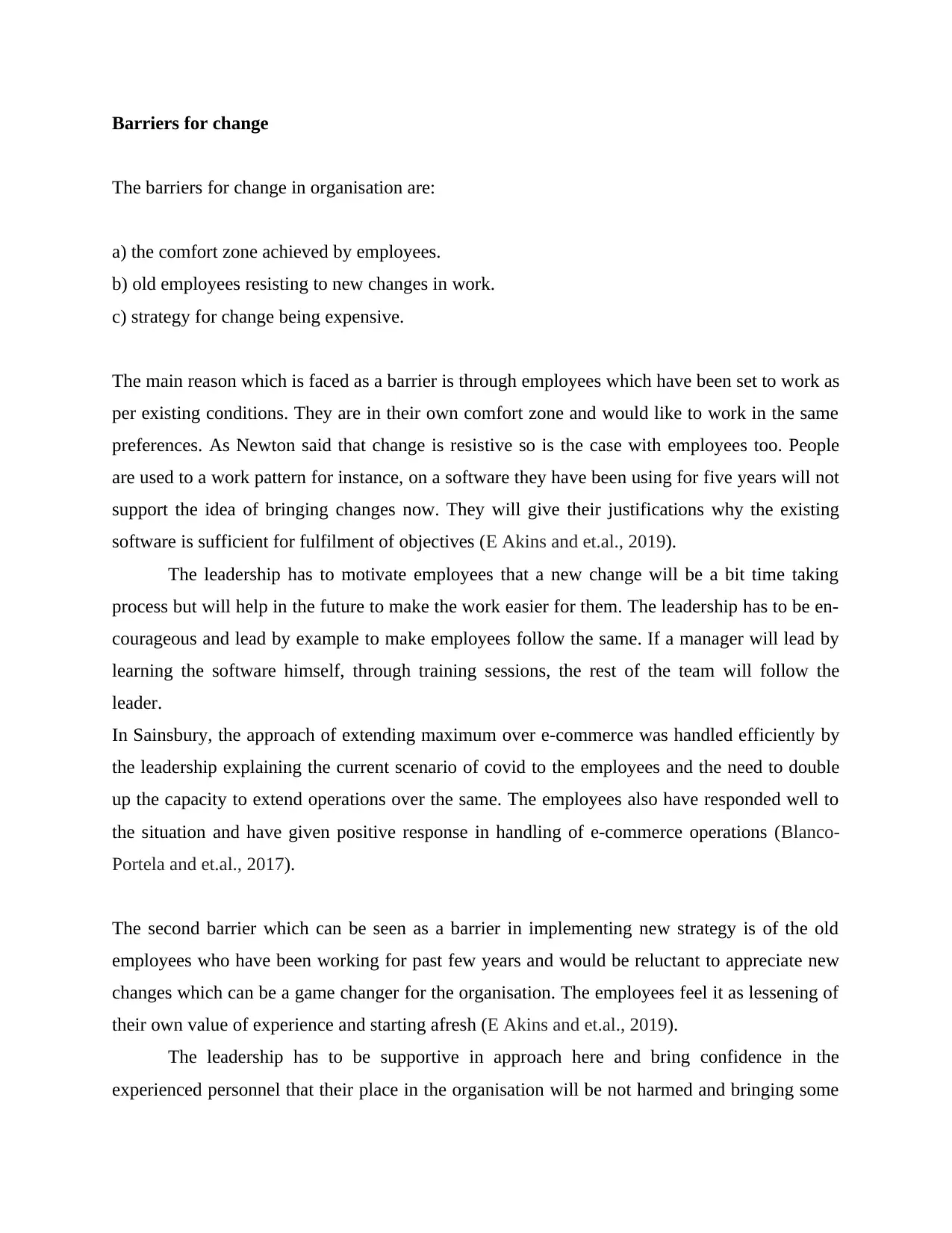
Barriers for change
The barriers for change in organisation are:
a) the comfort zone achieved by employees.
b) old employees resisting to new changes in work.
c) strategy for change being expensive.
The main reason which is faced as a barrier is through employees which have been set to work as
per existing conditions. They are in their own comfort zone and would like to work in the same
preferences. As Newton said that change is resistive so is the case with employees too. People
are used to a work pattern for instance, on a software they have been using for five years will not
support the idea of bringing changes now. They will give their justifications why the existing
software is sufficient for fulfilment of objectives (E Akins and et.al., 2019).
The leadership has to motivate employees that a new change will be a bit time taking
process but will help in the future to make the work easier for them. The leadership has to be en-
courageous and lead by example to make employees follow the same. If a manager will lead by
learning the software himself, through training sessions, the rest of the team will follow the
leader.
In Sainsbury, the approach of extending maximum over e-commerce was handled efficiently by
the leadership explaining the current scenario of covid to the employees and the need to double
up the capacity to extend operations over the same. The employees also have responded well to
the situation and have given positive response in handling of e-commerce operations (Blanco-
Portela and et.al., 2017).
The second barrier which can be seen as a barrier in implementing new strategy is of the old
employees who have been working for past few years and would be reluctant to appreciate new
changes which can be a game changer for the organisation. The employees feel it as lessening of
their own value of experience and starting afresh (E Akins and et.al., 2019).
The leadership has to be supportive in approach here and bring confidence in the
experienced personnel that their place in the organisation will be not harmed and bringing some
The barriers for change in organisation are:
a) the comfort zone achieved by employees.
b) old employees resisting to new changes in work.
c) strategy for change being expensive.
The main reason which is faced as a barrier is through employees which have been set to work as
per existing conditions. They are in their own comfort zone and would like to work in the same
preferences. As Newton said that change is resistive so is the case with employees too. People
are used to a work pattern for instance, on a software they have been using for five years will not
support the idea of bringing changes now. They will give their justifications why the existing
software is sufficient for fulfilment of objectives (E Akins and et.al., 2019).
The leadership has to motivate employees that a new change will be a bit time taking
process but will help in the future to make the work easier for them. The leadership has to be en-
courageous and lead by example to make employees follow the same. If a manager will lead by
learning the software himself, through training sessions, the rest of the team will follow the
leader.
In Sainsbury, the approach of extending maximum over e-commerce was handled efficiently by
the leadership explaining the current scenario of covid to the employees and the need to double
up the capacity to extend operations over the same. The employees also have responded well to
the situation and have given positive response in handling of e-commerce operations (Blanco-
Portela and et.al., 2017).
The second barrier which can be seen as a barrier in implementing new strategy is of the old
employees who have been working for past few years and would be reluctant to appreciate new
changes which can be a game changer for the organisation. The employees feel it as lessening of
their own value of experience and starting afresh (E Akins and et.al., 2019).
The leadership has to be supportive in approach here and bring confidence in the
experienced personnel that their place in the organisation will be not harmed and bringing some
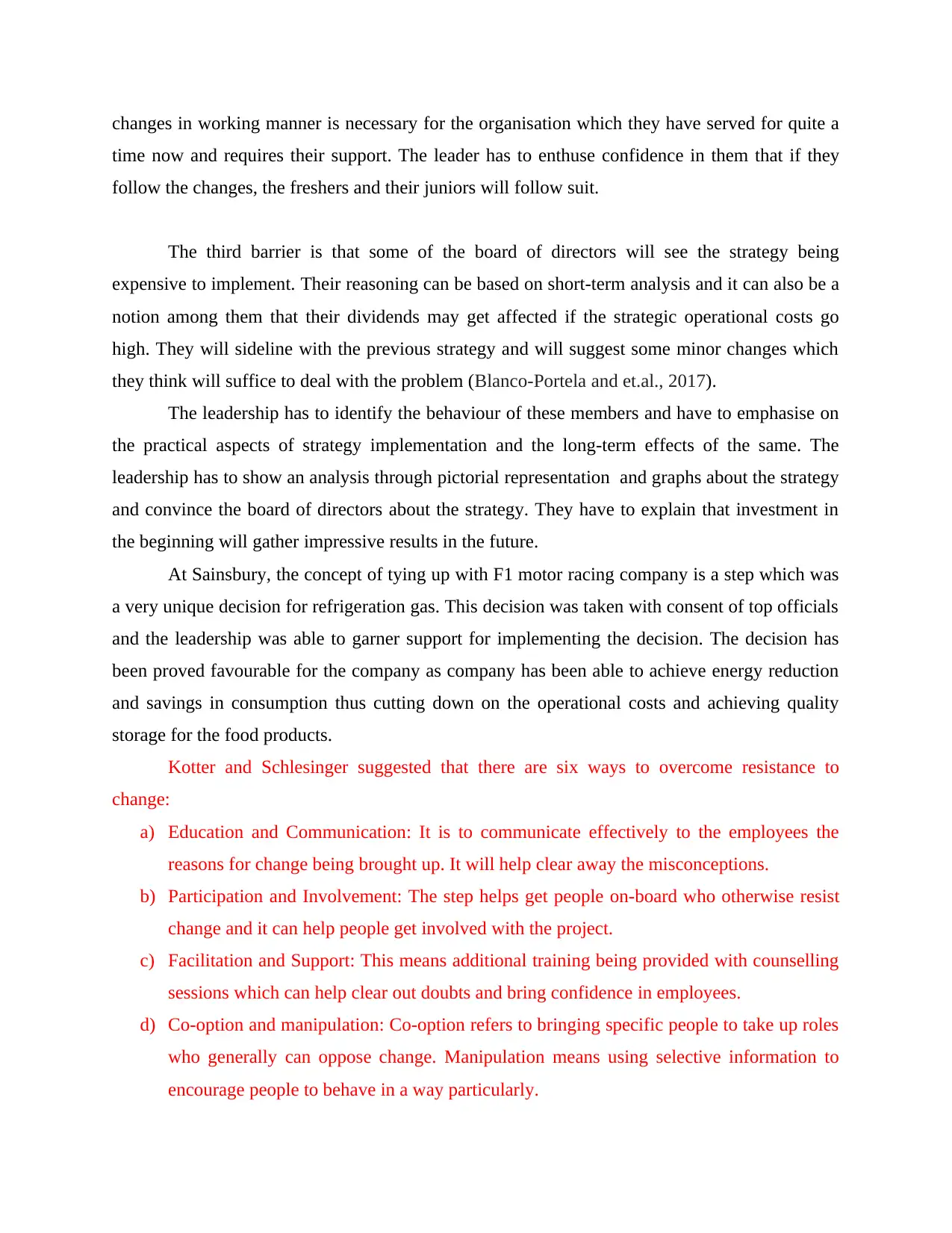
changes in working manner is necessary for the organisation which they have served for quite a
time now and requires their support. The leader has to enthuse confidence in them that if they
follow the changes, the freshers and their juniors will follow suit.
The third barrier is that some of the board of directors will see the strategy being
expensive to implement. Their reasoning can be based on short-term analysis and it can also be a
notion among them that their dividends may get affected if the strategic operational costs go
high. They will sideline with the previous strategy and will suggest some minor changes which
they think will suffice to deal with the problem (Blanco-Portela and et.al., 2017).
The leadership has to identify the behaviour of these members and have to emphasise on
the practical aspects of strategy implementation and the long-term effects of the same. The
leadership has to show an analysis through pictorial representation and graphs about the strategy
and convince the board of directors about the strategy. They have to explain that investment in
the beginning will gather impressive results in the future.
At Sainsbury, the concept of tying up with F1 motor racing company is a step which was
a very unique decision for refrigeration gas. This decision was taken with consent of top officials
and the leadership was able to garner support for implementing the decision. The decision has
been proved favourable for the company as company has been able to achieve energy reduction
and savings in consumption thus cutting down on the operational costs and achieving quality
storage for the food products.
Kotter and Schlesinger suggested that there are six ways to overcome resistance to
change:
a) Education and Communication: It is to communicate effectively to the employees the
reasons for change being brought up. It will help clear away the misconceptions.
b) Participation and Involvement: The step helps get people on-board who otherwise resist
change and it can help people get involved with the project.
c) Facilitation and Support: This means additional training being provided with counselling
sessions which can help clear out doubts and bring confidence in employees.
d) Co-option and manipulation: Co-option refers to bringing specific people to take up roles
who generally can oppose change. Manipulation means using selective information to
encourage people to behave in a way particularly.
time now and requires their support. The leader has to enthuse confidence in them that if they
follow the changes, the freshers and their juniors will follow suit.
The third barrier is that some of the board of directors will see the strategy being
expensive to implement. Their reasoning can be based on short-term analysis and it can also be a
notion among them that their dividends may get affected if the strategic operational costs go
high. They will sideline with the previous strategy and will suggest some minor changes which
they think will suffice to deal with the problem (Blanco-Portela and et.al., 2017).
The leadership has to identify the behaviour of these members and have to emphasise on
the practical aspects of strategy implementation and the long-term effects of the same. The
leadership has to show an analysis through pictorial representation and graphs about the strategy
and convince the board of directors about the strategy. They have to explain that investment in
the beginning will gather impressive results in the future.
At Sainsbury, the concept of tying up with F1 motor racing company is a step which was
a very unique decision for refrigeration gas. This decision was taken with consent of top officials
and the leadership was able to garner support for implementing the decision. The decision has
been proved favourable for the company as company has been able to achieve energy reduction
and savings in consumption thus cutting down on the operational costs and achieving quality
storage for the food products.
Kotter and Schlesinger suggested that there are six ways to overcome resistance to
change:
a) Education and Communication: It is to communicate effectively to the employees the
reasons for change being brought up. It will help clear away the misconceptions.
b) Participation and Involvement: The step helps get people on-board who otherwise resist
change and it can help people get involved with the project.
c) Facilitation and Support: This means additional training being provided with counselling
sessions which can help clear out doubts and bring confidence in employees.
d) Co-option and manipulation: Co-option refers to bringing specific people to take up roles
who generally can oppose change. Manipulation means using selective information to
encourage people to behave in a way particularly.
⊘ This is a preview!⊘
Do you want full access?
Subscribe today to unlock all pages.

Trusted by 1+ million students worldwide
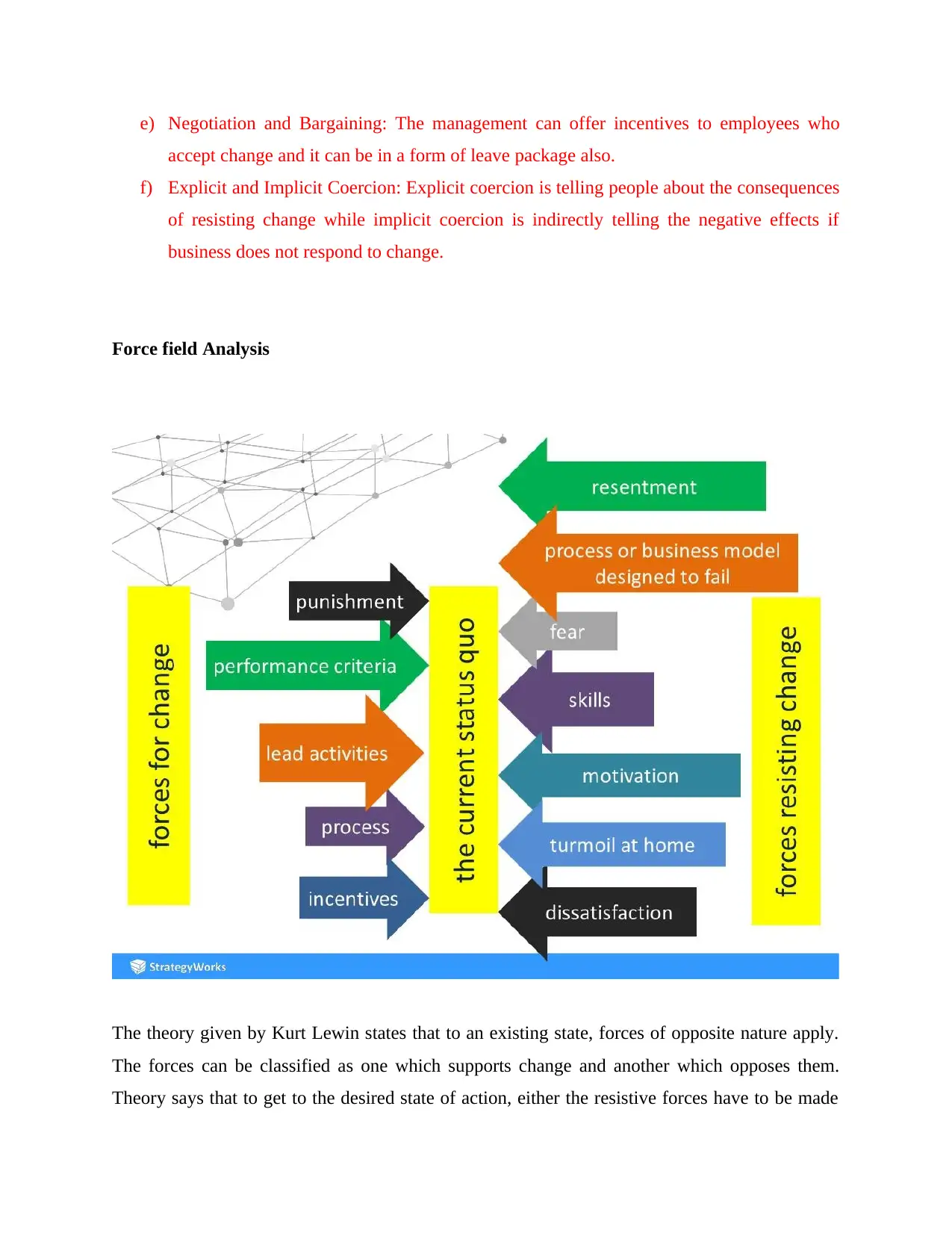
e) Negotiation and Bargaining: The management can offer incentives to employees who
accept change and it can be in a form of leave package also.
f) Explicit and Implicit Coercion: Explicit coercion is telling people about the consequences
of resisting change while implicit coercion is indirectly telling the negative effects if
business does not respond to change.
Force field Analysis
The theory given by Kurt Lewin states that to an existing state, forces of opposite nature apply.
The forces can be classified as one which supports change and another which opposes them.
Theory says that to get to the desired state of action, either the resistive forces have to be made
accept change and it can be in a form of leave package also.
f) Explicit and Implicit Coercion: Explicit coercion is telling people about the consequences
of resisting change while implicit coercion is indirectly telling the negative effects if
business does not respond to change.
Force field Analysis
The theory given by Kurt Lewin states that to an existing state, forces of opposite nature apply.
The forces can be classified as one which supports change and another which opposes them.
Theory says that to get to the desired state of action, either the resistive forces have to be made
Paraphrase This Document
Need a fresh take? Get an instant paraphrase of this document with our AI Paraphraser
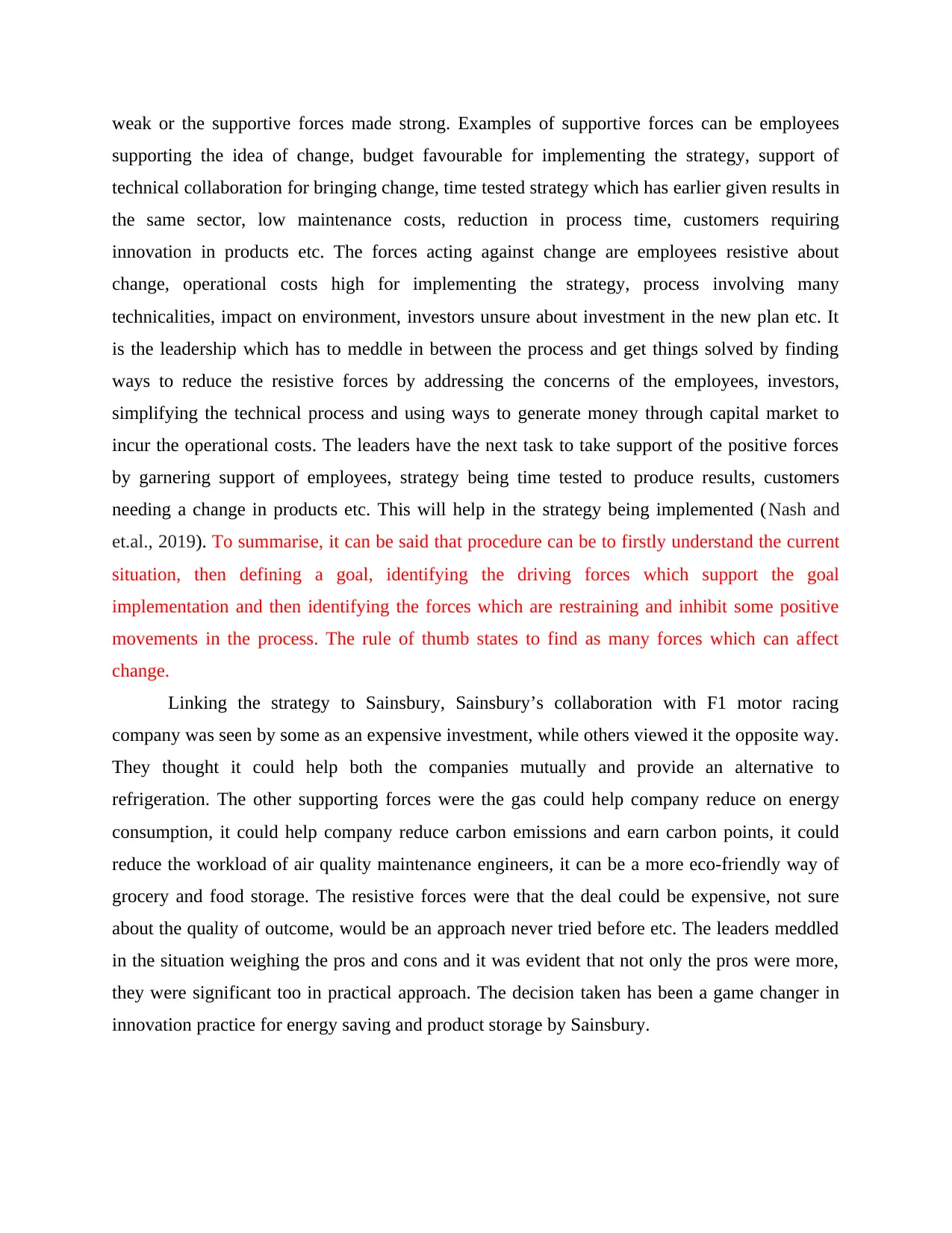
weak or the supportive forces made strong. Examples of supportive forces can be employees
supporting the idea of change, budget favourable for implementing the strategy, support of
technical collaboration for bringing change, time tested strategy which has earlier given results in
the same sector, low maintenance costs, reduction in process time, customers requiring
innovation in products etc. The forces acting against change are employees resistive about
change, operational costs high for implementing the strategy, process involving many
technicalities, impact on environment, investors unsure about investment in the new plan etc. It
is the leadership which has to meddle in between the process and get things solved by finding
ways to reduce the resistive forces by addressing the concerns of the employees, investors,
simplifying the technical process and using ways to generate money through capital market to
incur the operational costs. The leaders have the next task to take support of the positive forces
by garnering support of employees, strategy being time tested to produce results, customers
needing a change in products etc. This will help in the strategy being implemented (Nash and
et.al., 2019). To summarise, it can be said that procedure can be to firstly understand the current
situation, then defining a goal, identifying the driving forces which support the goal
implementation and then identifying the forces which are restraining and inhibit some positive
movements in the process. The rule of thumb states to find as many forces which can affect
change.
Linking the strategy to Sainsbury, Sainsbury’s collaboration with F1 motor racing
company was seen by some as an expensive investment, while others viewed it the opposite way.
They thought it could help both the companies mutually and provide an alternative to
refrigeration. The other supporting forces were the gas could help company reduce on energy
consumption, it could help company reduce carbon emissions and earn carbon points, it could
reduce the workload of air quality maintenance engineers, it can be a more eco-friendly way of
grocery and food storage. The resistive forces were that the deal could be expensive, not sure
about the quality of outcome, would be an approach never tried before etc. The leaders meddled
in the situation weighing the pros and cons and it was evident that not only the pros were more,
they were significant too in practical approach. The decision taken has been a game changer in
innovation practice for energy saving and product storage by Sainsbury.
supporting the idea of change, budget favourable for implementing the strategy, support of
technical collaboration for bringing change, time tested strategy which has earlier given results in
the same sector, low maintenance costs, reduction in process time, customers requiring
innovation in products etc. The forces acting against change are employees resistive about
change, operational costs high for implementing the strategy, process involving many
technicalities, impact on environment, investors unsure about investment in the new plan etc. It
is the leadership which has to meddle in between the process and get things solved by finding
ways to reduce the resistive forces by addressing the concerns of the employees, investors,
simplifying the technical process and using ways to generate money through capital market to
incur the operational costs. The leaders have the next task to take support of the positive forces
by garnering support of employees, strategy being time tested to produce results, customers
needing a change in products etc. This will help in the strategy being implemented (Nash and
et.al., 2019). To summarise, it can be said that procedure can be to firstly understand the current
situation, then defining a goal, identifying the driving forces which support the goal
implementation and then identifying the forces which are restraining and inhibit some positive
movements in the process. The rule of thumb states to find as many forces which can affect
change.
Linking the strategy to Sainsbury, Sainsbury’s collaboration with F1 motor racing
company was seen by some as an expensive investment, while others viewed it the opposite way.
They thought it could help both the companies mutually and provide an alternative to
refrigeration. The other supporting forces were the gas could help company reduce on energy
consumption, it could help company reduce carbon emissions and earn carbon points, it could
reduce the workload of air quality maintenance engineers, it can be a more eco-friendly way of
grocery and food storage. The resistive forces were that the deal could be expensive, not sure
about the quality of outcome, would be an approach never tried before etc. The leaders meddled
in the situation weighing the pros and cons and it was evident that not only the pros were more,
they were significant too in practical approach. The decision taken has been a game changer in
innovation practice for energy saving and product storage by Sainsbury.
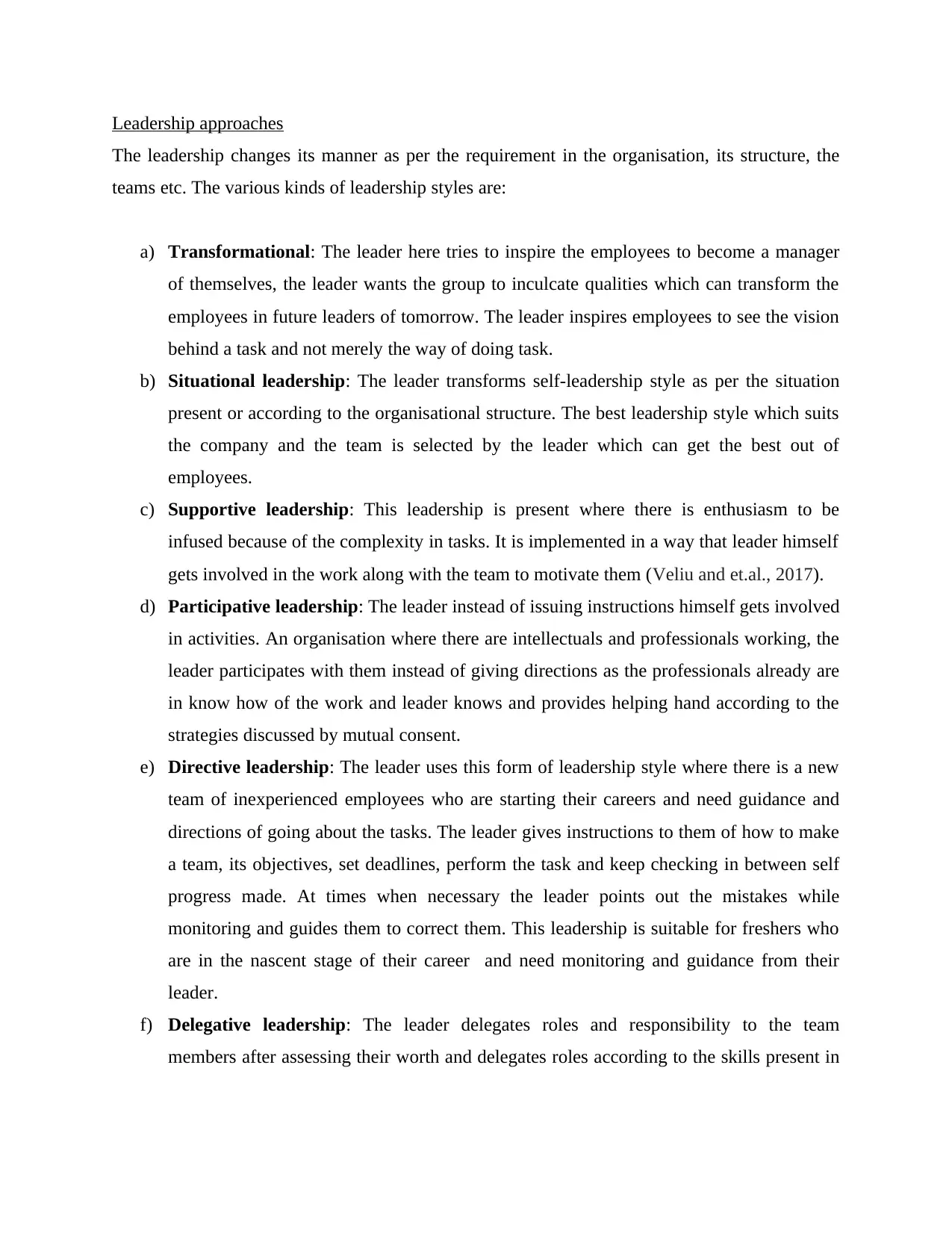
Leadership approaches
The leadership changes its manner as per the requirement in the organisation, its structure, the
teams etc. The various kinds of leadership styles are:
a) Transformational: The leader here tries to inspire the employees to become a manager
of themselves, the leader wants the group to inculcate qualities which can transform the
employees in future leaders of tomorrow. The leader inspires employees to see the vision
behind a task and not merely the way of doing task.
b) Situational leadership: The leader transforms self-leadership style as per the situation
present or according to the organisational structure. The best leadership style which suits
the company and the team is selected by the leader which can get the best out of
employees.
c) Supportive leadership: This leadership is present where there is enthusiasm to be
infused because of the complexity in tasks. It is implemented in a way that leader himself
gets involved in the work along with the team to motivate them (Veliu and et.al., 2017).
d) Participative leadership: The leader instead of issuing instructions himself gets involved
in activities. An organisation where there are intellectuals and professionals working, the
leader participates with them instead of giving directions as the professionals already are
in know how of the work and leader knows and provides helping hand according to the
strategies discussed by mutual consent.
e) Directive leadership: The leader uses this form of leadership style where there is a new
team of inexperienced employees who are starting their careers and need guidance and
directions of going about the tasks. The leader gives instructions to them of how to make
a team, its objectives, set deadlines, perform the task and keep checking in between self
progress made. At times when necessary the leader points out the mistakes while
monitoring and guides them to correct them. This leadership is suitable for freshers who
are in the nascent stage of their career and need monitoring and guidance from their
leader.
f) Delegative leadership: The leader delegates roles and responsibility to the team
members after assessing their worth and delegates roles according to the skills present in
The leadership changes its manner as per the requirement in the organisation, its structure, the
teams etc. The various kinds of leadership styles are:
a) Transformational: The leader here tries to inspire the employees to become a manager
of themselves, the leader wants the group to inculcate qualities which can transform the
employees in future leaders of tomorrow. The leader inspires employees to see the vision
behind a task and not merely the way of doing task.
b) Situational leadership: The leader transforms self-leadership style as per the situation
present or according to the organisational structure. The best leadership style which suits
the company and the team is selected by the leader which can get the best out of
employees.
c) Supportive leadership: This leadership is present where there is enthusiasm to be
infused because of the complexity in tasks. It is implemented in a way that leader himself
gets involved in the work along with the team to motivate them (Veliu and et.al., 2017).
d) Participative leadership: The leader instead of issuing instructions himself gets involved
in activities. An organisation where there are intellectuals and professionals working, the
leader participates with them instead of giving directions as the professionals already are
in know how of the work and leader knows and provides helping hand according to the
strategies discussed by mutual consent.
e) Directive leadership: The leader uses this form of leadership style where there is a new
team of inexperienced employees who are starting their careers and need guidance and
directions of going about the tasks. The leader gives instructions to them of how to make
a team, its objectives, set deadlines, perform the task and keep checking in between self
progress made. At times when necessary the leader points out the mistakes while
monitoring and guides them to correct them. This leadership is suitable for freshers who
are in the nascent stage of their career and need monitoring and guidance from their
leader.
f) Delegative leadership: The leader delegates roles and responsibility to the team
members after assessing their worth and delegates roles according to the skills present in
⊘ This is a preview!⊘
Do you want full access?
Subscribe today to unlock all pages.

Trusted by 1+ million students worldwide
1 out of 17
Related Documents
Your All-in-One AI-Powered Toolkit for Academic Success.
+13062052269
info@desklib.com
Available 24*7 on WhatsApp / Email
![[object Object]](/_next/static/media/star-bottom.7253800d.svg)
Unlock your academic potential
Copyright © 2020–2025 A2Z Services. All Rights Reserved. Developed and managed by ZUCOL.





